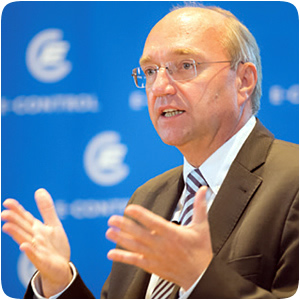 Europe is undergoing a far reaching energy transition in order to decarbonise all aspects of our daily lives and this in a relatively short period. The overarching mission is to move towards a zero-emission, carbon-neutral Europe. The pathway is clear: decarbonising the economy by 2050 in the order of 80-95% compared to 1990, achieving along the way reductions of at least 40% by 2030 and 60% by 2040.
Europe is undergoing a far reaching energy transition in order to decarbonise all aspects of our daily lives and this in a relatively short period. The overarching mission is to move towards a zero-emission, carbon-neutral Europe. The pathway is clear: decarbonising the economy by 2050 in the order of 80-95% compared to 1990, achieving along the way reductions of at least 40% by 2030 and 60% by 2040.
In light of the ambitious decarbonisation targets, it is evident that the energy transition process has to be stepped up. To reach the emission reduction and renewable production goals in the energy sector, some advocate an "all- electric world", where energy is produced as renewable electricity, stored as electricity and all end-applications are switched to electrical appliances.
However, some recent studies and assessments (Frontier) have found that this transition to an "all-electric world" is neither technically feasible nor economically acceptable because it would significantly increase the energy costs for private and industrial consumers. Indeed, full electrification by using exclusively intermittent renewable sources would require smarter and stronger electricity grids, wide-spread introduction of flexibility measures, and higher levels of (seasonal) storage and back-up generation capacity.
It is therefore necessary to investigate specifically whether, to which extent and how gas and gas infrastructure can be compatible with the climate objectives and deliver cost-effective solutions to achieve the energy transition. This will also require investigating optimal use of the infrastructure building on synergies and interactions between the gas and electricity sectors.
My vision of the future European energy system in this regard is clear: it is one of a dual or hybrid model based first and foremost on electricity from renewable sources but sustained and complemented by renewable and decarbonised gas.
With such a hybrid model the European energy system would be much stronger and more resilient because it could be based on two independent and at the same time complementary energy resources and infrastructures. Large quantities of renewable gases can be produced within Europe reducing the import dependency of the European energy system.
And even more: While the energy transition in the EU has so far focused on the electricity sector, it now needs to encompass heat, transport and industrial consumption. The interfaces between both electricity and gas grids and the integration of multiple technologies will increase the resilience of the overall system efficiency The underlying concept is called "sectoral integration" or "sector coupling".
Such a combined approach of renewable electricity with renewable and low-carbon gases would not only lead to quite substantive savings in the energy transition process but would also deliver on economic growth, job creation and strengthening EU's position as a leader in innovative energy technologies.
In the short term, natural gas can play an important role in decarbonising the EU's energy system by replacing more carbon emitting fossil fuels, notably hard coal and lignite. There is no way reaching our climate targets without radically change the share of coal and lignite in the energy mix.
In the mid-term, natural gas will be needed as a back-up or bridge fuel for the increasing production of electricity from renewable sources, mainly wind and solar. Gas is the ideal back-up technology for variable renewables characterised by a high flexibility for balancing the integration of renewable generation (more flexible compared to nuclear production) and by the lowest CO2-intensity of fossil fuels.
For the long-term, however, there is a challenge. If natural gas is to remain in the EU energy mix, until 2050 and beyond, it has to be fully decarbonised. This clearly entails massive deployment of technologies as well as related costs and likely regulatory changes. In this context Carbon Capture and Storage (CCS)/Usage (CCU) will have to play a decisive role.
The decarbonisation of natural gas will be increasingly complemented by the development of renewable gases. Renewable gases have been gradually emerging in the European energy market as possible alternatives to natural gas in several applications. At present, bio-methane and biogas represent the main source of renewable gases in Europe with hydrogen showing a growing potential. Thanks to its particular characteristics, hydrogen is able to contribute to achieving the climate goals and to translate them into economic activities. Hydrogen is an energy carrier that can be made out of all other energy sources. It can be used as a transport fuel, converted back to electricity or injected into the natural gas network.
One promising option is the power-to-gas technology. It allows renewable electricity to be converted and stored as a gas. This is of particular interest for Europe where the combined generating capacity of offshore wind farms could reach around 100 GW by the year 2030 and the PV capacity installed is expected to increase to almost 60 GW in 2020. Using power-to-gas technology could help to accommodate these quantities of renewable electricity.
However, the precise composition of energy carriers in our future energy system is surrounded with high uncertainty when a time horizon up to 2030 and 2050 is taken.
The exact combination of different technologies will best be determined by market forces, finding the most efficient way to reach ambitious policy objectives in a technology neutral manner. The main objective should be removing any existing regulatory barriers or fill any potentially existing regulatory gaps to create a level-playing field.
In order for the future to happen, a structured cooperation between the renewable electricity and gas sector on the one hand and an intense cooperation with the energy intensive industries is required. Furthermore, a dialogue between the electricity and gas sectors and their customers in the transport and heating sector is essential.